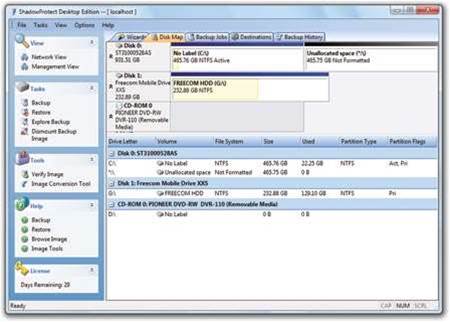StorageCraft ShadowProtect SPX provides backup and disaster recovery for Windows, Linux and mixed IT environments. StorageCraft ShadowProtect Desktop Edition creates an automatic online backup of your entire system including the operating system, applications, personal.
When it comes to selecting Backup software product, buyers are primarily concerned about its cost. In fact, it is the cost that determines whether a potential buyer would go with the product. True, there is no one-size-fits-all formula to determine the “worth” of a software product, but as a software buyer, you want to make sure you get the best value for your money, without having to dig a big hole in your pocket. Understanding the exact price of Backup Software isn't easy as The overall cost of software includes the cost of software license, subscription fees, software training cost, customization cost, required hardware, and the cost of maintenance & support and other related services. It's critical that you account for all of these costs to gain an understanding of the system's 'total cost of ownership.' Pricing Models: There are primarily three common pricing models – Perpetual License, Subscription, and Commercial open source.
• Perpetual license: A common pricing model for on-premise applications, perpetual license requires a customer to pay an upfront sum to own the software or other intellectual property on-premises for a fixed term. • Upfront cost involves the fee for installation, customization, integration with existing systems, besides perpetual license fee. Microsoft Powerpoint 2004 (mac). • Recurring cost is low in this pricing model and may include cost for updates, maintenance, upgrades, and patches. Some vendors do offer premium support services, which come for an extra price. • Subscription/Software-As-A-Service: Under this software pricing model, the software is accessed over the Internet, as opposed to installed on-premises. The payment is made either on a per user basis or subscription basis.


Ideally, customers are required to pay a recurring monthly fee until a specific period for using the software. Subscription pricing model is more common with Software-as-a-Service (SaaS) apps. • Upfront cost for customization and integration is less compared to perpetual license cost because there is not much flexibility with SaaS systems in this area. • Recurring cost is greater as customers are required to make monthly payments as subscription fee. Additionally customers using premium support services must pay an extra fee. All in all, the total cost of ownership in the both cases is almost the same and may span over a period of 7-10 years, though you may have to pay a higher perpetual license fee upfront. The software cost may vary from starter to mid range to enterprise level apps in both cases.
• Commercial open source: The customer can acquire the software free of cost without having to incur any upfront license fee. As a customer, you’re solely responsible for the ongoing maintenance, upgrading, customization, and troubleshooting of the application to meet your specific needs.
You are on your own for providing end-user support, since you are not locked in with a vendor-supplied software solution. Torrent Ray Lamontagne. ShadowProtect Desktop Edition customization cost: If you need specific features in your software catering to your specific business requirements, the vendor will charge customization cost, depending on your needs and feature requirement. Ideally customization cost is more complex to calculate compared to licensing cost. Some apps allow you to easily combine data from multiple sources, without any complicated query requirements, while some others can be embedded into different applications to provide enhanced reporting. If you seek products that support customizable dashboards and predictive analysis to identity possible trends and facilitate decision making, you may have to pay higher for all the customization features. Additionally, the following factors may affect the cost of customization: • User interface changes • Configurable dashboards • Data elements required for tracking • Forms to collect additional data • Dashboard, management and operational reports that are needed. • Workflows and how complex they are.